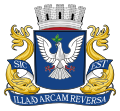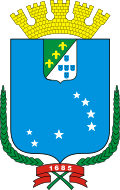This gallery of coats of arms of Brazilian regions shows the coats of the 26 Brazilian States and the Federal District.
This gallery of coats of arms of Brazilian regions shows the coats of the 26 Brazilian States and the Federal District.
This gallery of coats of arms of Brazilian states shows the coats of the 26 Brazilian State capitals and the Federal District.
| Name | Arms |
|---|---|
| Aracaju, SE Coat of Arms of Aracaju |  |
| Belém, PA Coat of Arms of Belém |  |
| Belo Horizonte, MG Coat of Arms of Belo Horizonte |  |
| Boa Vista, RR Coat of Arms of Boa Vista (Roraima) |  |
| Campo Grande, MS Coat of Arms of Campo Grande (Mato Grosso do Sul) |  |
| Cuiabá, MT Coat of Arms of Cuiabá |  |
| Curitiba, PR Coat of Arms of Curitiba |  |
| Florianópolis, SC Coat of Arms of Florianópolis |  |
| Fortaleza, CE Coat of Arms of Fortaleza |  |
| Goiânia, GO Coat of Arms of Goiânia |  |
| João Pessoa, PB Coat of Arms of João Pessoa |  |
| Macapá, AP Coat of Arms of Macapá |  |
| Maceió, AL Coat of Arms of Maceió |  |
| Manaus, AM Coat of Arms of Manaus |  |
| Natal, RN Coat of Arms of Natal |  |
| Palmas, TO Coat of Arms of Palmas |  |
| Porto Alegre, RS Coat of Arms of Porto Alegre |  |
| Porto Velho, RO Coat of Arms of Porto Velho |  |
| Recife, PE Coat of Arms of Recife |  |
| Rio Branco, AC Coat of Arms of Rio Branco (Acre) |  |
| Rio de Janeiro, RJ Coat of Arms of Rio de Janeiro |  |
| Salvador, BA Coat of Arms of Salvador |  |
| São Luís, MA Coat of Arms of São Luís (Maranhão) |  |
| São Paulo, SP Coat of Arms of São Paulo |  |
| Teresina, PI Coat of Arms of Teresina |  |
| Vitória, ES Coat of Arms of Vitória |  |
| Name | Arms |
|---|---|
| Brasília, DF |  |